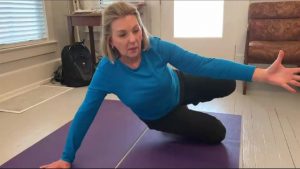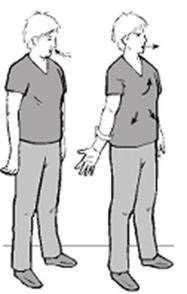When it comes to fixing rounded shoulders and forward head posture for the long term, you must get to your core.
Today you are transported into my treatment and training space for a mini case study documenting a successful conservative care approach to a patient with 3 compression fractures in her upper back.
The goal was to essentially transform her upper body posture so she did not continue to place stress on your upper back vertebrae.
We use a combination of DNS (dynamic neuromuscular stabilization) transition exercises, breath retraining, Yoga, resistance band exercises, and of course, releasing and rewiring dysfunctional movement patterns / traps.
This segment uses some transitions taken from the 7 to 9 month old period of infant neurodevelopment using high oblique sit.
The first one, the transition to “bear”, was too much and created some neck pain. So you’ll see the “peel back” exercise that you can also use train your “upright” posture system.
This is also a lesson. Every exercise is a test. You should know what mistakes or “traps” to look for in the transitions when performing an exercise so you can modify if necessary.
——————————–
(If you’re interested in a free online “Transition with Grace” web class sharing some of the most common dysfunctional and damaging movement traps that lead to painful and unhealthy aging and how to fix them, click here. A new tab will open up so you can continue with this post and video)
——————————–
The others are Yoga variants and what I call the “Banded Brugger”, taken from the famous “Brugger Posture Relief Position” (see image to right).
Every person is different and unique. But there are definitely predictable posture and movement patterns that occur and can lumped into the “Crossed Posture Syndrome” (CPS) pattern.
All you have to do is go back to infant neurodevelopment to see what “ideal” is. Then look at a kiddo with cerebral palsy and you’ll see the maximum, intense expression of CPS.
The stress of life tends to slowly close us down and fold us inward if we don’t keep good body awareness and have a strategy for intentionally staying upright!
That’s where I will continue to keep my focus. Sharing strategies with you so you can stay OPEN with less strain, less pain, and more energy and confidence to keep doing the things you love.
Again…you can learn more in our free web class on the most common damaging movement mistakes that lead to strain, pain, and unhealthy aging. Just click the button below the video and you’ll be set.
Enjoy and leave any questions or feedback in the comment section below.


Thank you Donna. I live in California, and I have been a fan of Dr. Steve for years. I know he can help you, and I appreciate you going in front of the camera. He couldn’t have picked a prettier model. Just keep following his instructions. Hope we get to see more videos of your progress.
Mary
Los Gatos, CA
She’s a sport! And such a model of inspiration.
Thank you.
I liked the small movement in oblique sit. A great exercise to watch posture and strengthen.
I especially liked the reminder to keep the neck long and spine and shoulders down,. Lately I’ve been gently widening my shoulders as I push away into posture so i don’t pull my shoulders backward.
And I liked the external rotation with a band using Bruegers exercise which I haven’t done for years
Of course for the next day or two I will replay to make sure I have the movements and transitions right.
And of course with all to remember my 360 breathing.
These could not have come at a better time because in Minnesota weather this time of year I do not get a lot of outdoor activity
Just keep pushing away from support, Leona!